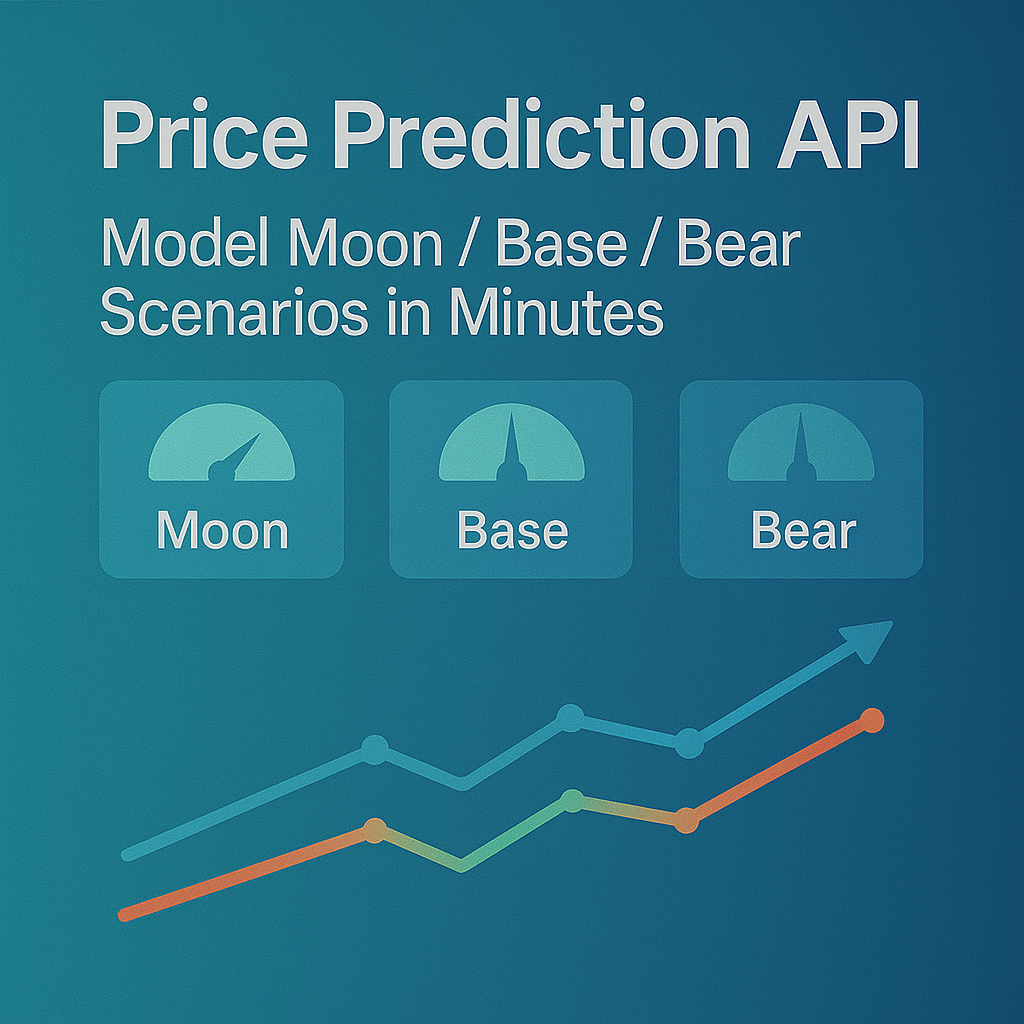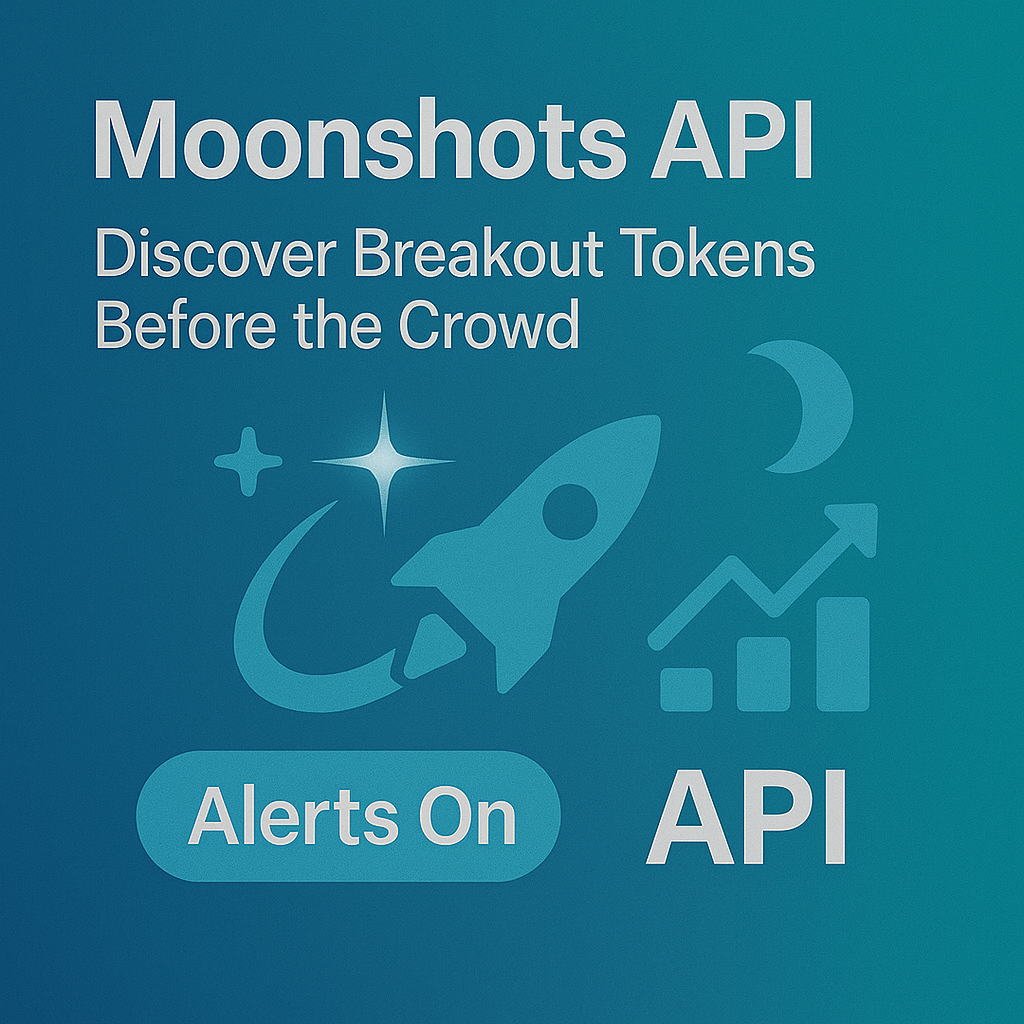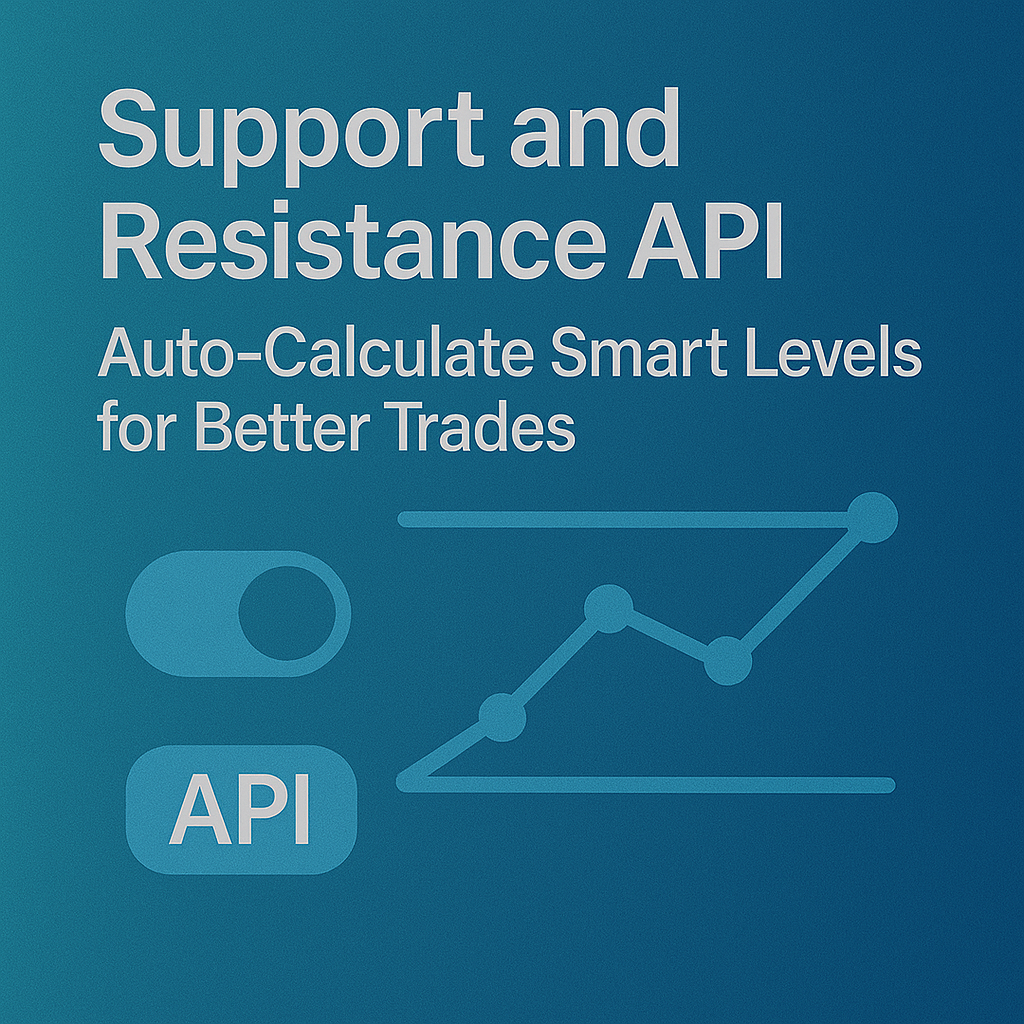Top Crypto Trading Platforms in 2025







%201.svg)
%201.svg)
Big news: We’re cranking up the heat on AI-driven crypto analytics with the launch of the Token Metrics API and our official SDK (Software Development Kit). This isn’t just an upgrade – it's a quantum leap, giving traders, hedge funds, developers, and institutions direct access to cutting-edge market intelligence, trading signals, and predictive analytics.
Crypto markets move fast, and having real-time, AI-powered insights can be the difference between catching the next big trend or getting left behind. Until now, traders and quants have been wrestling with scattered data, delayed reporting, and a lack of truly predictive analytics. Not anymore.
The Token Metrics API delivers 32+ high-performance endpoints packed with powerful AI-driven insights right into your lap, including:
Getting started with the Token Metrics API is simple:
At Token Metrics, we believe data should be decentralized, predictive, and actionable.
The Token Metrics API & SDK bring next-gen AI-powered crypto intelligence to anyone looking to trade smarter, build better, and stay ahead of the curve. With our official SDK, developers can plug these insights into their own trading bots, dashboards, and research tools – no need to reinvent the wheel.
%201.svg)
%201.svg)
The biggest gains in crypto rarely come from the majors. They come from Moonshots—fast-moving tokens with breakout potential. The Moonshots API surfaces these candidates programmatically so you can rank, alert, and act inside your product. In this guide, you’ll call /v2/moonshots, display a high-signal list with TM Grade and Bullish tags, and wire it into bots, dashboards, or screeners in minutes. Start by grabbing your key at Get API Key, then Run Hello-TM and Clone a Template to ship fast.
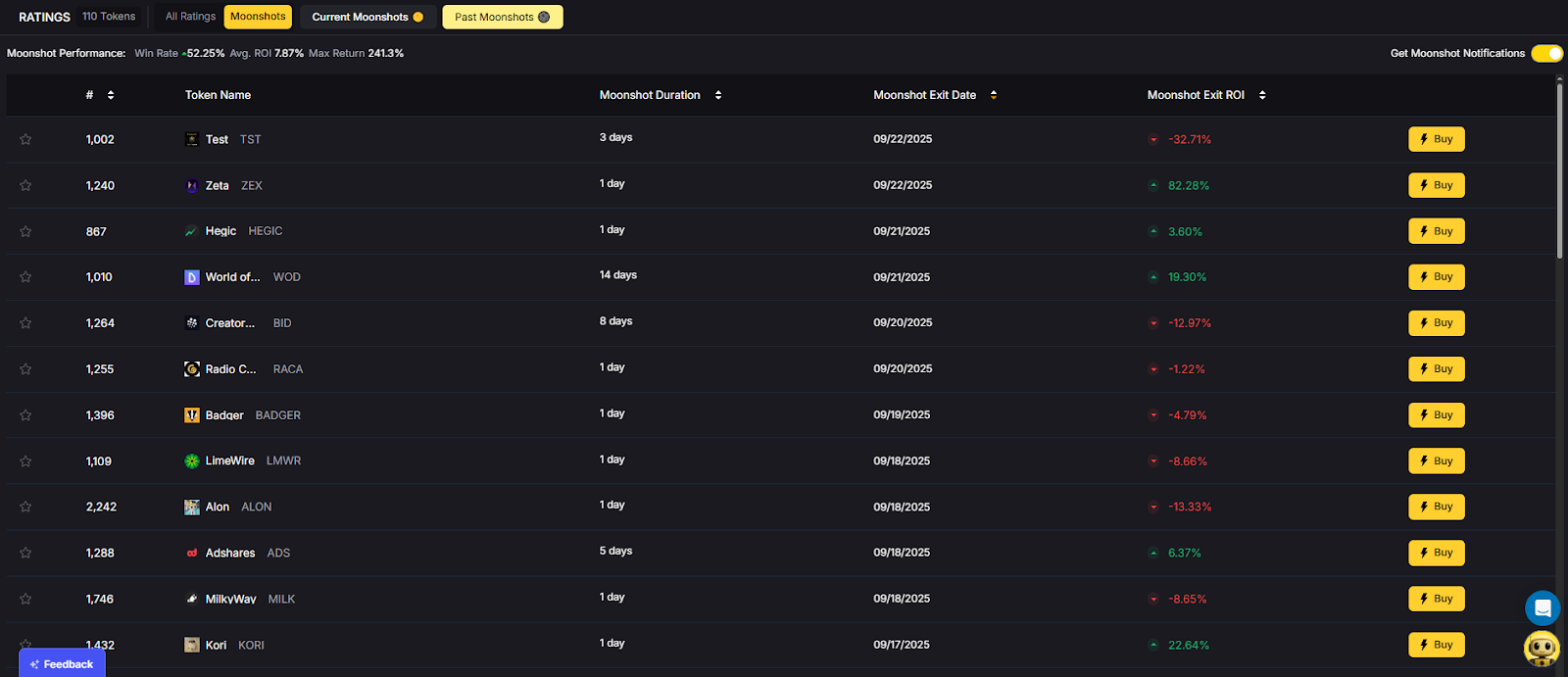
Discovery that converts. Users want more than price tickers—they want a curated, explainable list of high-potential tokens. The moonshots API encapsulates multiple signals into a short list designed for exploration, alerts, and watchlists you can monetize.
Built for builders. The endpoint returns a consistent schema with grade, signal, and context so you can immediately sort, badge, and trigger workflows. With predictable latency and clear filters, you can scale to dashboards, mobile apps, and headless bots without reinventing the discovery pipeline.
The Moonshots API cURL request is right there in the top right of the API Reference. Grab it and start tapping into the potential!
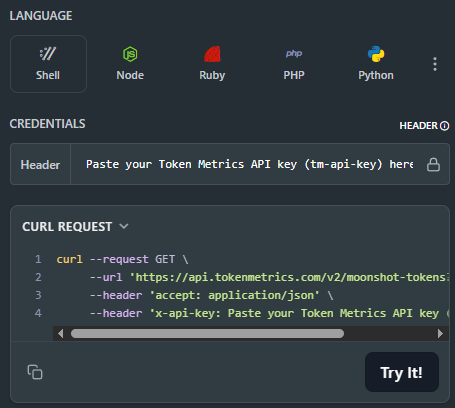
👉 Keep momentum: Get API Key • Run Hello-TM • Clone a Template
Fork a screener or alerting template, plug your key, and deploy. Validate your environment with Hello-TM. When you scale users or need higher limits, compare API plans.
The Moonshots endpoint aggregates a set of evidence—often combining TM Grade, signal state, and momentum/volume context—into a shortlist of breakout candidates. Each row includes a symbol, grade, signal, and timestamp, plus optional reason tags for transparency.
For UX, a common pattern is: headline list → token detail where you render TM Grade (quality), Trading Signals (timing), Support/Resistance (risk placement), Quantmetrics (risk-adjusted performance), and Price Prediction scenarios. This lets users understand why a token was flagged and how to act with risk controls.
Polling vs webhooks. Dashboards typically poll with short-TTL caching. Alerting flows use scheduled jobs or webhooks (where available) to smooth traffic and avoid duplicates. Always make notifications idempotent.
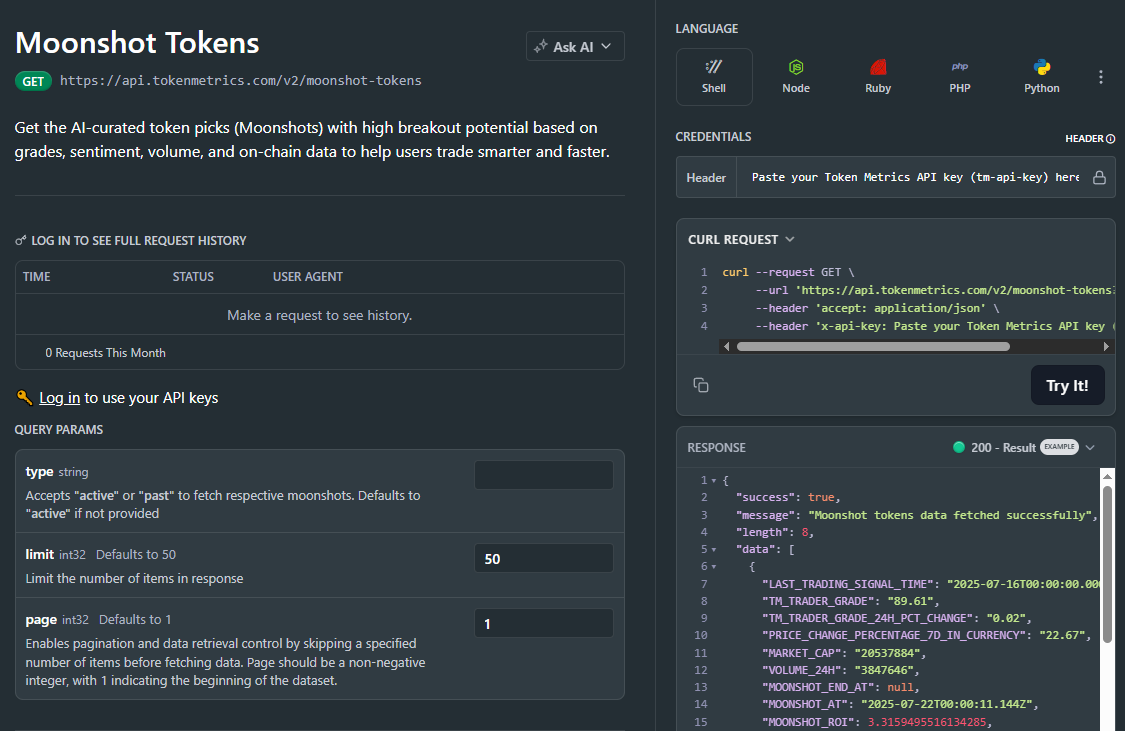
1) What does the Moonshots API return?
A list of breakout candidates with fields such as symbol, tm_grade, signal (often Bullish/Bearish), optional reason tags, and updated_at. Use it to drive discover tabs, alerts, and watchlists.
2) How fresh is the list? What about latency/SLOs?
The endpoint targets predictable latency and timely updates for dashboards and alerts. Use short-TTL caching and queued jobs/webhooks to avoid bursty polling.
3) How do I use Moonshots in a trading workflow?
Common stack: Moonshots for discovery, Trading Signals for timing, Support/Resistance for SL/TP, Quantmetrics for sizing, and Price Prediction for scenario context. Always backtest and paper-trade first.
4) I saw results like “+241%” and a “7.5% average return.” Are these guaranteed?
No. Any historical results are illustrative and not guarantees of future performance. Markets are risky; use risk management and testing.
5) Can I filter the Moonshots list?
Yes—pass parameters like min_grade, signal, and limit (as supported) to tailor to your audience and keep pages fast.
6) Do you provide SDKs or examples?
REST works with JavaScript and Python snippets above. Docs include quickstarts, Postman collections, and templates—start with Run Hello-TM.
7) Pricing, limits, and enterprise SLAs?
Begin free and scale up. See API plans for rate limits and enterprise options.
%201.svg)
%201.svg)
Most traders still draw lines by hand in TradingView. The support and resistance API from Token Metrics auto-calculates clean support and resistance levels from one request, so your dashboard, bot, or alerts can react instantly. In minutes, you’ll call /v2/resistance-support, render actionable levels for any token, and wire them into stops, targets, or notifications. Start by grabbing your key on Get API Key, then Run Hello-TM and Clone a Template to ship a production-ready feature fast.
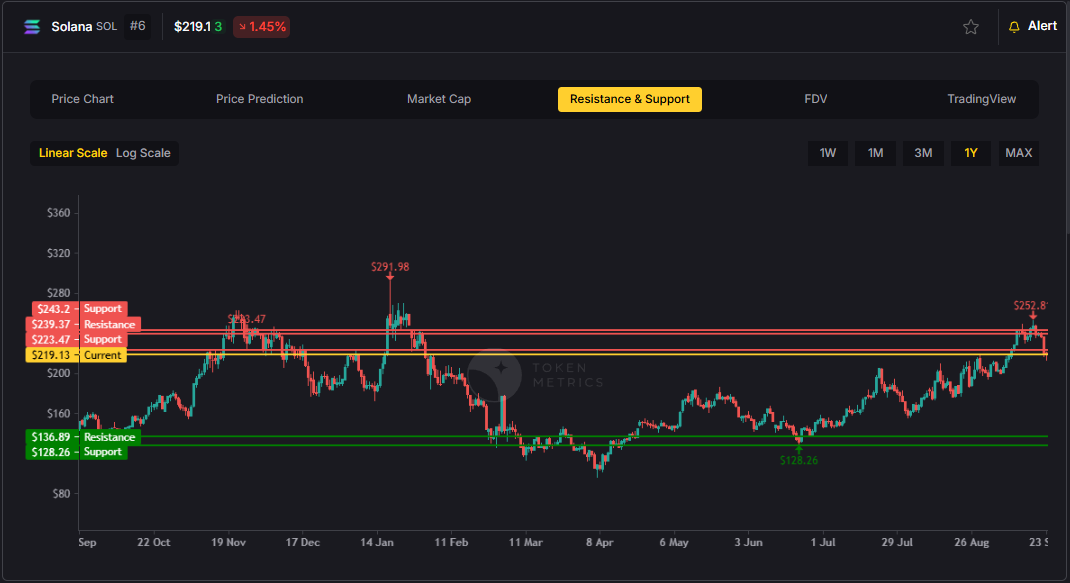
Precision beats guesswork. Hand-drawn lines are subjective and slow. The support and resistance API standardizes levels across assets and timeframes, enabling deterministic stops and take-profits your users (and bots) can trust.
Production-ready by design. A simple REST shape, predictable latency, and clear semantics let you add levels to token pages, automate SL/TP alerts, and build rule-based execution with minimal glue code.
Need the Support and Resistance data? The cURL request for it is in the top right of the API Reference for quick access.
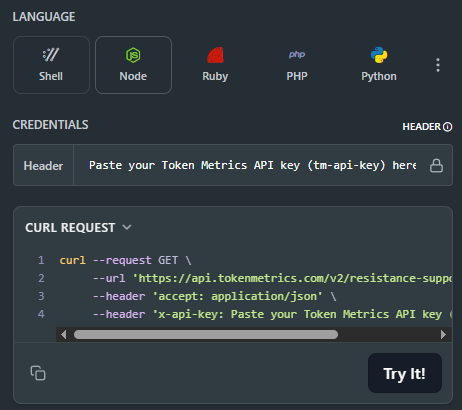
👉 Keep momentum: Get API Key • Run Hello-TM • Clone a Template
Kick off with our quickstarts—fork a bot or dashboard template, plug your key, and deploy. Confirm your environment by Running Hello-TM. When you’re scaling or need webhooks/limits, review API plans.
The Support/Resistance endpoint analyzes recent price structure to produce discrete levels above and below current price, along with strength indicators you can use for priority and styling. Query /v2/resistance-support?symbol=<ASSET>&timeframe=<HORIZON> to receive arrays of level objects and timestamps.
Polling vs webhooks. For dashboards, short-TTL caching and batched fetches keep pages snappy. For bots and alerts, use queued jobs or webhooks (where applicable) to avoid noisy, bursty polling—especially around market opens and major events.
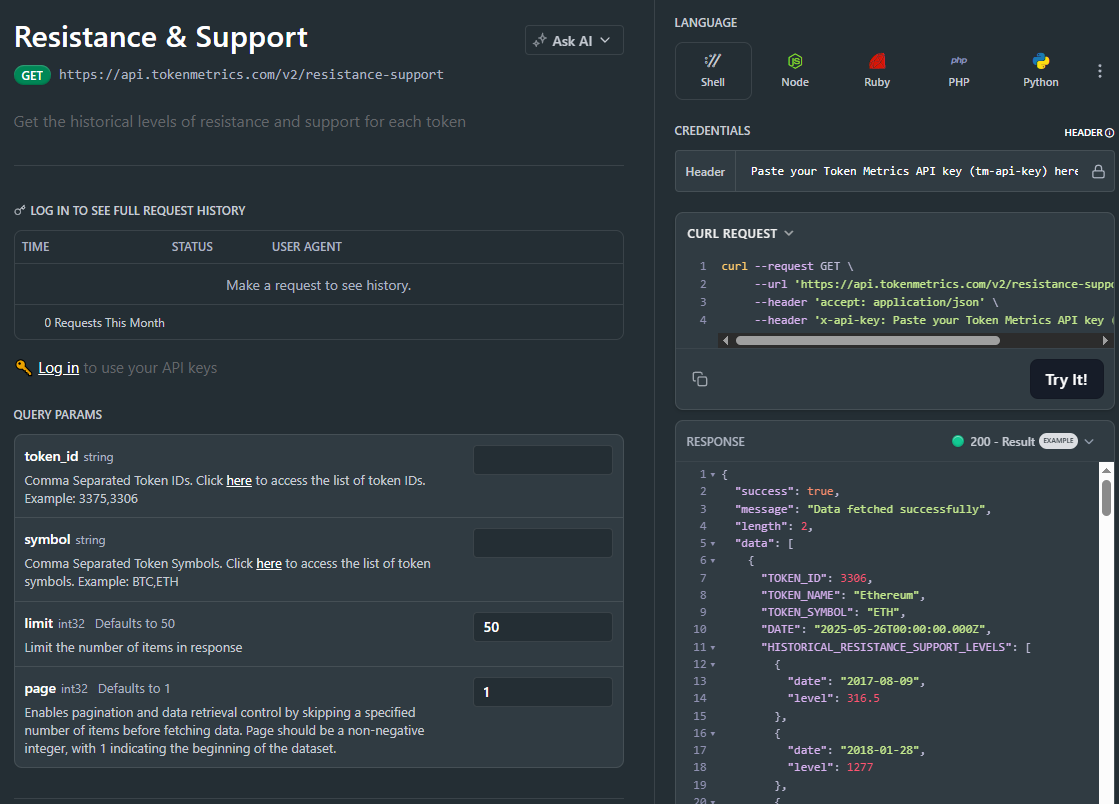
1) What does the Support & Resistance API return?
A JSON payload with arrays of support and resistance levels for a symbol (and optional timeframe), each with a price and strength indicator, plus an update timestamp.
2) How timely are the levels? What are the latency/SLOs?
The endpoint targets predictable latency suitable for dashboards and alerts. Use short-TTL caching for UIs, and queued jobs or webhooks for alerting to smooth traffic.
3) How do I trigger alerts or trades from levels?
Common patterns: alert when price is within X% of a level, touches a level, or breaks beyond with confirmation. Always make downstream actions idempotent and respect rate limits.
4) Can I combine levels with other endpoints?
Yes—pair with /v2/trading-signals for timing, /v2/tm-grade for quality context, and /v2/quantmetrics for risk sizing. This yields a complete decide-plan-execute loop.
5) Which timeframe should I use?
Intraday bots prefer shorter horizons; swing/position dashboards use daily or higher-timeframe levels. Offer a timeframe toggle and cache results per setting.
6) Do you provide SDKs or examples?
Use the REST snippets above (JS/Python). The docs include quickstarts, Postman collections, and templates—start with Run Hello-TM.
7) Pricing, limits, and enterprise SLAs?
Begin free and scale as you grow. See API plans for rate limits and enterprise SLA options.
%201.svg)
%201.svg)
Most traders see price—quants see probabilities. The Quantmetrics API turns raw performance into risk-adjusted stats like Sharpe, Sortino, volatility, drawdown, and CAGR so you can compare tokens objectively and build smarter bots and dashboards. In minutes, you’ll query /v2/quantmetrics, render a clear performance snapshot, and ship a feature that customers trust. Start by grabbing your key at Get API Key, Run Hello-TM to verify your first call, then Clone a Template to go live fast.
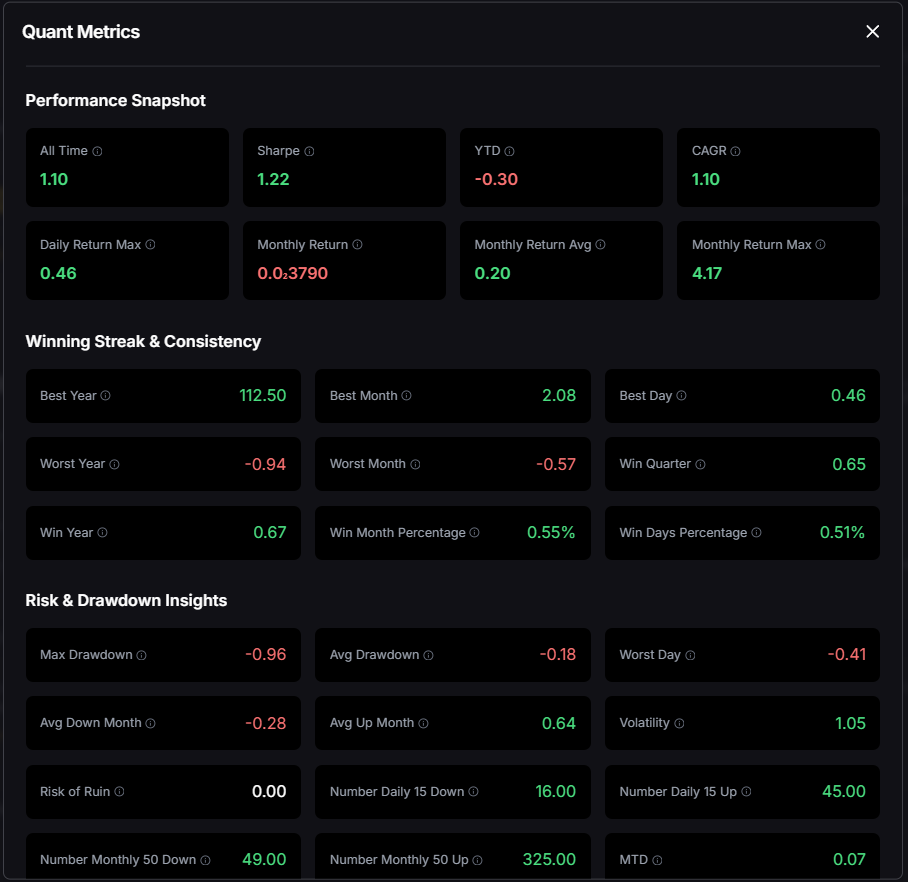
Risk-adjusted truth beats hype. Price alone hides tail risk and whipsaws. Quantmetrics compresses edge, risk, and consistency into metrics that travel across assets and timeframes—so you can rank universes, size positions, and communicate performance like a pro.
Built for dev speed. A clean REST schema, predictable latency, and easy auth mean you can plug Sharpe/Sortino into bots, dashboards, and screeners without maintaining your own analytics pipeline. Pair with caching and batching to serve fast pages at scale.
The Quant Metrics cURL request is located in the top right of the API Reference, allowing you to easily integrate it with your application.
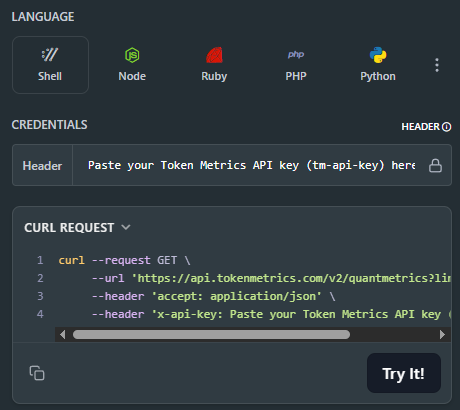
👉 Keep momentum: Get API Key • Run Hello-TM • Clone a Template
Kick off from quickstarts in the docs—fork a dashboard or screener template, plug your key, and deploy in minutes. Validate your environment with Run Hello-TM; when you need more throughput or webhooks, compare API plans.
Quantmetrics computes risk-adjusted performance over a chosen lookback (e.g., 30d, 90d, 1y). You’ll receive a JSON snapshot with core statistics:
Call /v2/quantmetrics?symbol=<ASSET>&window=<LOOKBACK> to fetch the current snapshot. For dashboards spanning many tokens, batch symbols and apply short-TTL caching. If you generate alerts (e.g., “Sharpe crossed 1.5”), run a scheduled job and queue notifications to avoid bursty polling.
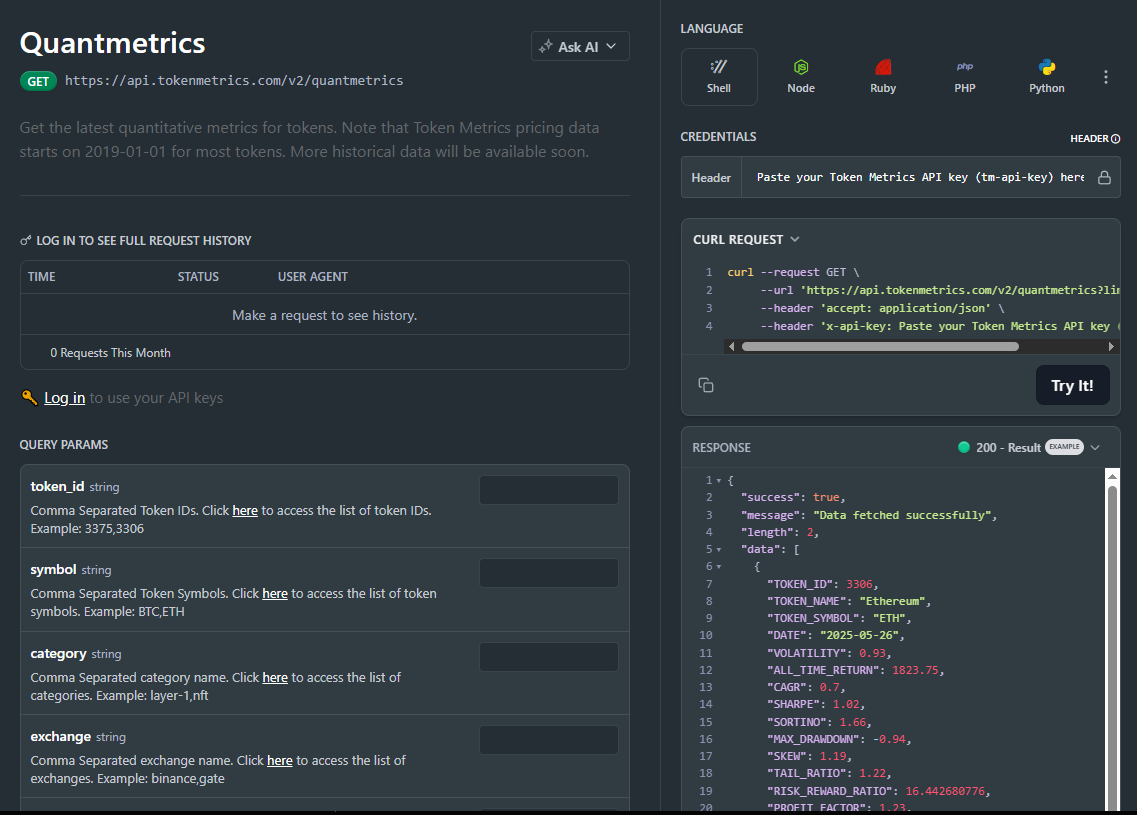
1) What does the Quantmetrics API return?
A JSON snapshot of risk-adjusted metrics (e.g., Sharpe, Sortino, volatility, max drawdown, CAGR) for a symbol and lookback window—ideal for ranking, sizing, and dashboards.
2) How fresh are the stats? What about latency/SLOs?
Responses are engineered for predictable latency. For heavy UI usage, add short-TTL caching and batch requests; for alerts, use scheduled jobs or webhooks where available.
3) Can I use Quantmetrics to size positions in a live bot?
Yes—many quants size inversely to volatility or require Sharpe ≥ X to trade. Always backtest and paper-trade before going live; past results are illustrative, not guarantees.
4) Which lookback window should I choose?
Short windows (30–90d) adapt faster but are noisier; longer windows (6–12m) are steadier but slower to react. Offer users a toggle and cache each window.
5) Do you provide SDKs or examples?
REST is straightforward (JS/Python above). Docs include quickstarts, Postman collections, and templates—start with Run Hello-TM.
6) Polling vs webhooks for quant alerts?
Dashboards usually use cached polling. For threshold alerts (e.g., Sharpe crosses 1.0), run scheduled jobs and queue notifications to keep usage smooth and idempotent.
7) Pricing, limits, and enterprise SLAs?
Begin free and scale up. See API plans for rate limits and enterprise SLA options.

%201.svg)
%201.svg)
In a market that never sleeps, the best crypto newsletters 2025 help you filter noise, spot narratives early, and act with conviction. In one line: a great newsletter or analyst condenses complex on-chain, macro, and market structure data into clear, investable insights. Whether you’re a builder, long-term allocator, or active trader, pairing independent analysis with your own process can tighten feedback loops and reduce decision fatigue. In 2025, ETF flows, L2 expansion, AI infra plays, and global regulation shifts mean more data than ever. The picks below focus on consistency, methodology transparency, breadth (on-chain + macro + market), and practical takeaways—blending independent crypto analysts with data-driven research letters and easy-to-digest daily briefs.
Secondary intents we cover: crypto research newsletter, on-chain analysis weekly, and “who to follow” for credible signal over hype.





Primary CTA: Start free trial

This article is for research/education, not financial advice.
What makes a crypto newsletter “best” in 2025?
Frequency, methodological transparency, and the ability to translate on-chain/macro signals into practical takeaways. Bonus points for archives and clear disclosures.
Are the top newsletters free or paid?
Most offer strong free tiers (daily or weekly). Paid tiers typically unlock deeper research, models, or community access.
Do I need both on-chain and macro letters?
Ideally yes—on-chain explains market structure; macro sets the regime (liquidity, rates, growth). Pairing both creates a more complete view.
How often should I read?
Skim dailies (Bankless/Milk Road) for awareness; reserve time weekly for deep dives (Glassnode/Coin Metrics/Delphi).
Can newsletters replace analytics tools?
No. Treat them as curated insight. Validate ideas with your own data and risk framework (Token Metrics can help).
Which is best for ETF/flows?
CoinShares’ weekly Fund Flows is the go-to for institutional positioning, complemented by Glassnode/Coin Metrics on structure.
If you want a quick pulse, pick a daily (Bankless or Milk Road). For deeper conviction, add one weekly on-chain (Glassnode or Coin Metrics) and one thesis engine (Delphi or Messari). Layer macro (Lyn Alden) to frame the regime, and use Token Metrics to quantify what you read and act deliberately.
Related Reads:
We reviewed each provider’s official newsletter hub, research pages, and recent posts to confirm availability, cadence, and focus. Updated September 2025 with the latest archives and program pages. Key official references: Bankless newsletter hub Bankless+2Bankless+2; The Defiant newsletter page The Defiant+1; Messari newsletter hub and Unqualified Opinions pages Messari+2messari.substack.com+2; Delphi Digital newsletter page and research site Delphi Digital+2delphidigital.io+2; Glassnode Week On-Chain hub and latest issue insights.glassnode.com+2Glassnode+2; Coin Metrics SOTN hub and archive Coin Metrics+2Coin Metrics+2; Kaiko research/newsletter hub and company site Kaiko Research+1; CoinShares Fund Flows & Research hubs (US/global) and latest weekly example CoinShares+2CoinShares+2; Milk Road homepage and social proof Milk Road+1; Lyn Alden newsletter/archive pages and 2025 issues Lyn Alden+4Lyn Alden+4Lyn Alden+4.

%201.svg)
%201.svg)
Crypto moves fast—and the gap between hype and real skills can be costly. If you’re evaluating the best crypto courses or structured paths to go from zero to fluent (or from power user to builder), the right program can compress months of trial-and-error into weeks. In short: a crypto education platform is any structured program, course catalog, or academy that teaches blockchain, Web3, or digital-asset topics with clear outcomes (e.g., literacy, developer skills, startup readiness).
This guide curates 10 credible options across beginner literacy, smart-contract engineering, and founder tracks. We blend SERP research with hands-on criteria so you can match a course to your goals, time, and budget—without the fluff.
Data sources: official provider pages (program docs, security/FAQ, curriculum), plus widely cited market datasets for cross-checks only. Last updated September 2025.





Primary CTA: Start free trial.

This article is for research/education, not financial advice.
What’s the fastest way to start learning crypto in 2025?
Start with a free literacy hub (Binance Academy or Coinbase Learn), then audit a university course (Coursera/edX) before committing to a paid bootcamp. This builds intuition and saves money. Binance+2Coinbase+2
Which course is best if I want to become a Solidity developer?
Alchemy University is a free, hands-on path with in-browser coding; ConsenSys Academy adds mentor-led structure and team projects for professional polish. Alchemy+1
Do I need a formal degree for crypto careers?
Not strictly. A portfolio of projects often trumps certificates, but formal programs like UNIC’s MSc can help for policy, compliance, or academia-adjacent roles. University of Nicosia
Are these programs global and online?
Most are fully online and globally accessible; accelerators like a16z CSX may run cohorts in specific cities, so check the latest cohort details. a16z crypto
Will these courses cover wallet and security best practices?
University and dev bootcamps typically include security modules; literacy hubs also publish safety guides. Always cross-check with official docs and practice in testnets. Consensys - The Ethereum Company+1
If your goal is literacy and safe onboarding, start with Binance Academy or Coinbase Learn; for academic depth, layer in Coursera (Princeton) or edX (Berkeley). Builders should choose Alchemy University (free) and consider ConsenSys Academy for mentor-led polish. For credentials, UNIC stands out. Founders ready to ship and raise should explore a16z Crypto’s CSX.
Related Reads:
We verified each provider’s official pages for curriculum, format, and access. Third-party datasets were used only to cross-check prominence. Updated September 2025.

%201.svg)
%201.svg)
The flood of information in crypto makes trusted voices indispensable. The top crypto influencers 2025 help you filter noise, spot narratives early, and pressure-test ideas across Twitter/X, YouTube, and TikTok. This guide ranks the most useful creators and media brands for research, education, and market awareness—whether you’re an individual investor, a builder, or an institution.
Definition: A crypto influencer/KOL is a creator or publication with outsized reach and demonstrated ability to shape attention, educate audiences, and surface on-chain or market insights. We emphasize track record, transparency, and multi-platform presence. Secondary terms like best crypto KOLs, crypto YouTubers, and crypto Twitter accounts are woven in naturally to match search intent.

Why Use It: Token Metrics combines human analysts with AI ratings and on-chain/quant models, packaging insights via YouTube shows, tutorials, and research articles. The mix of data-driven screening and narrative detection makes it a strong daily driver for both retail and pro users. YouTube+1
Best For: Retail investors, swing traders, token research teams, and institutions seeking systematic signals.
Notable Features: AI Ratings & Signals; narrative heat detection; portfolio tooling; explainers and live shows.
Fees Notes: Free videos/reports; paid analytics tiers available.
Regions: Global.
Alternatives: Coin Bureau, Bankless.

Why Use It: Guy and team are known for accessible, well-structured education across tokens, tech, and regulation—ideal for learning fast without sensationalism. Their site and channel organize guides, analysis, and “what to know before you invest” content. Coin Bureau+1
Best For: Beginners, researchers, compliance-minded readers.
Notable Features: Long-form explainers; project primers; timely macro/market narratives.
Fees Notes: Content is free; optional merchandise/membership.
Regions: Global.
Alternatives: Finematics, Token Metrics.

Why Use It: Bankless blends interviews with founders and policymakers, DeFi primers, and a consistent macro lens. The podcast + YouTube combo and a busy newsletter make it a top “frontier finance” feed. Bankless+1
Best For: Builders, protocol teams, power users.
Notable Features: Deep interviews; airdrop and ecosystem roundups; policy/regulatory conversations.
Fees Notes: Many resources free; paid tiers/newsletters optional.
Regions: Global.
Alternatives: The Defiant (news), Coin Bureau.
Why Use It: The Arnold brothers deliver high-frequency coverage of market movers, narratives, and interviews, helping you catch headlines and sentiment shifts quickly. Their channel is among the most active for crypto news. YouTube+1
Best For: News-driven traders, general crypto audiences.
Notable Features: Daily videos; interviews; quick market takes.
Fees Notes: Free content; affiliate links may appear with disclosures.
Regions: Global.
Alternatives: Crypto Banter, Token Metrics.
Why Use It: A live, broadcaster-style format covering Bitcoin, altcoins, and breaking news—with recurring hosts and trader segments. The emphasis is on real-time updates and community participation. cryptobanter.com+1
Best For: Intraday watchers, momentum traders, community-driven learning.
Notable Features: Daily live streams; trader panels; market reaction shows.
Fees Notes: Free livestreams; education and partners disclosed on site.
Regions: Global.
Alternatives: Altcoin Daily, Token Metrics.
Why Use It: Pomp’s daily show and interviews bridge crypto with broader finance and tech. He brings operators, investors, and policymakers into accessible conversations. New original programming on X complements his long-running podcast. Anthony Pompliano+1
Best For: Executives, allocators, macro-minded audiences.
Notable Features: Daily investor letter; interviews; X-native programming.
Fees Notes: Free content; newsletter and media subscriptions optional.
Regions: Global.
Alternatives: Bankless, Token Metrics.
Why Use It: Finematics turns complex DeFi mechanics (AMMs, MEV, L2s) into crisp animations and threads—great for leveling up from novice to competent operator. The YouTube channel is a staple for concept mastery. YouTube+1
Best For: Students of DeFi, analysts, product managers.
Notable Features: Animated explainers; topical primers (MEV, EIPs); extra tutorials on site.
Fees Notes: Free videos; optional Patreon/course material.
Regions: Global.
Alternatives: Coin Bureau, Bankless.
Why Use It: Clear, approachable tutorials on wallets, security, and portfolio basics; frequent refreshes for the latest best practices. Great first touch for friends and teammates new to crypto. YouTube+1
Best For: Beginners, educators, community managers.
Notable Features: Setup walk-throughs; safety tips; series for newcomers.
Fees Notes: Free channel; affiliate/sponsor disclosures in video descriptions.
Regions: Global.
Alternatives: Coin Bureau, Finematics.
Why Use It: Rekt Capital focuses on disciplined, cycle-aware technical analysis, especially for Bitcoin. The research newsletter and YouTube channel offer a consistent framework for understanding halving cycles, support/resistance, and macro phases. Rekt Capital+1
Best For: Swing traders, long-term allocators, TA learners.
Notable Features: Cycle maps; weekly newsletters; educational modules.
Fees Notes: Free posts + paid tiers; clear membership options.
Regions: Global.
Alternatives: Willy Woo, Token Metrics.
Why Use It: A pioneer in on-chain analytics, Willy popularized frameworks like NVT and shares models and charts used widely by analysts. His work bridges on-chain data with macro narrative, useful when markets de-correlate from headlines. charts.woobull.com+1
Best For: Data-driven investors, quant-curious traders.
Notable Features: On-chain models; charts (e.g., NVT); newsletter The Bitcoin Forecast.
Fees Notes: Free charts; paid newsletter available.
Regions: Global.
Alternatives: Token Metrics (quant + AI), Rekt Capital.


Primary CTA: Start free trial.

This article is for research/education, not financial advice.
What’s the fastest way to use this list?
Pick one education-first creator (Coin Bureau or Crypto Casey) and one market-first feed (Token Metrics, Bankless, or Altcoin Daily). Use Token Metrics to validate ideas before you act. Coin Bureau+2YouTube+2
Are these KOLs region-restricted?
Content is generally global, though some platforms may geo-restrict features or embeds. Always follow local rules for trading and taxes. (Check each creator’s site/channel for access details.) Coin Bureau+1
Who’s best for on-chain metrics?
Willy Woo popularized several on-chain valuation approaches and maintains public charts on Woobull/WooCharts, useful for cycle context. charts.woobull.com+1
I’m brand-new—where should I start?
Crypto Casey and Coin Bureau offer step-by-step explainers; then layer in Token Metrics for AI-assisted idea validation and alerts. YouTube+2Coin Bureau+2
How do I avoid shill content?
Look for disclosures, independent verification, and multiple sources. Cross-check KOL mentions with Token Metrics’ ratings and narratives before allocating.
KOLs are force multipliers when you pair them with your own process. Start with one education channel and one market channel, then layer Token Metrics to validate and monitor. Over time, you’ll recognize which voices best fit your strategy.
Related Reads:
We verified identities, formats, and focus areas using official sites, channels, and about pages; scale and programming notes were cross-checked with publicly available profiles and posts. Updated September 2025.
Willy Woo — Woobull, WooCharts, and NVT page. Woobull+2woocharts.com+2

%201.svg)
%201.svg)
If you trade, build, or invest in digital assets, your edge starts with information. The PRIMARY_KEYWORD—“best crypto media outlets”—are the publishers and platforms that break market-moving stories, explain complex narratives, and surface on-chain trends fast enough to act. In one line: A crypto media outlet is a specialized publisher that reports, analyzes, and contextualizes digital-asset markets and technology for investors and builders.
This guide is for retail traders, crypto-native professionals, and institutions comparing crypto news websites and blockchain news sites to build a trustworthy daily stack. We synthesized public info from official publisher pages and cross-checked coverage breadth, depth, and consistency. Below, you’ll find concise picks, a decision guide by use case, and a practical checklist so you can choose confidently.
We relied on official sites, about/trust pages, product pages, and disclosures; we used widely cited market datasets (e.g., CoinGecko/Kaiko/CCData) only to sanity-check scale claims. Last updated September 2025.



Pair trusted news with quant and AI to act with conviction:

Workflow: Research → Shortlist → Execute with your chosen venue → Monitor via TM alerts.

Primary CTA: Start free trial

This article is for research/education, not financial advice.
What is a crypto media outlet?
A publisher focused on digital-asset markets and technology—covering news, analysis, and explainers for traders, investors, and builders. Many also offer newsletters, podcasts, and events.
How many outlets should I follow daily?
Two to three complementary sources usually balance speed and depth (e.g., one generalist, one investigative/DeFi, one podcast). Add specialized feeds (e.g., Bitcoin-only) as needed.
Are paid crypto news subscriptions worth it?
They can be if you use the added depth (investigations, research notes, data). For most traders, a free stack plus one targeted premium product is sufficient.
Which outlet is best for U.S. regulatory coverage?
Generalists like CoinDesk and The Block cover U.S. policy closely; DL News and The Defiant provide strong DeFi/regulation analysis. Cross-check with official agency releases.
Where can I get crypto news in multiple languages?
Cointelegraph runs multilingual editions and apps; several outlets offer newsletters and region-specific writers. Verify language availability and local relevance.
Do these sites move markets?
Major scoops, enforcement actions, or exchange/security stories can move prices, especially in thin-liquidity hours. Use alerts and confirm via official disclosures.
The “best” outlet depends on your role and the decisions you make. If you need one primary feed, start with CoinDesk; add The Block for scoops and Blockworks for pro-grade audio. Layer DL News/The Defiant for DeFi and Bitcoin Magazine for BTC focus. As always, pair news with structured research and disciplined risk.
Related Reads:
We verified offerings and focus areas on each outlet’s official pages and current navigation, plus recent announcements. Cross-checks included widely cited market datasets to gauge breadth and cadence. Updated September 2025.

%201.svg)
%201.svg)
The metaverse has evolved from hype to practical utility: brands, creators, and gamers now use metaverse platforms to host events, build persistent worlds, and monetize experiences. In one line: a metaverse platform is a shared, real-time 3D world or network of worlds where users can create, socialize, and sometimes own digital assets. In 2025, this matters because cross-platform tooling (web/mobile/VR), better creator economics, and cleaner wallet flows are making virtual worlds useful—not just novel. Whether you’re a creator monetizing UGC, a brand running virtual activations, or a gamer seeking interoperable avatars and items, this guide compares the leaders and helps you pick the right fit. Secondary focus areas include web3 metaverse ownership models, virtual worlds with events/tools, and NFT avatars where relevant.
Data sources: official product/docs pages, security/transparency pages, and (for cross-checks) widely cited market datasets. Last updated September 2025.





Primary CTA: Start free trial

This article is for research/education, not financial advice.
What is a metaverse platform?
A shared, persistent 3D environment where users can create, socialize, and sometimes own assets (via wallets/NFTs). Some focus on events and galleries; others on UGC games or VR immersion.
Do I need crypto to use these platforms?
Not always. Spatial and some worlds allow non-crypto onboarding. Web3-native platforms often require wallets for asset ownership and trading.
Which platform is best for branded events?
The Sandbox (IP partnerships, seasons) and Spatial (cross-device ease) are top picks; Decentraland also hosts large community events.
What about VR?
Somnium Space is VR-first; Spatial also supports XR publishing. Confirm device lists and performance requirements.
Are assets portable across worlds?
Interoperability is improving (avatars, file formats), but true portability varies. Always check import/export support and license terms.
How do these platforms make money?
Typically via land sales, marketplace fees, subscriptions, or seasonal passes/rewards. Review fee pages and terms before committing.
What risks should I consider?
Platform changes, token volatility, phishing, and evolving terms. Start small, use official links, and secure wallets.
If you’re brand-led or IP-driven, start with The Sandbox or Spatial. For open web3 communities and DAO-style governance, consider Decentraland. Creators seeking premium visuals may prefer Mona, while Somnium Space fits VR die-hards. Social UGC gamers can thrive on Nifty Island; geo-builders on Upland; galleries on Oncyber; lightweight events on Voxels; and large NFT communities should watch Otherside as it develops.
Related Reads:
We validated claims on official product/docs pages and public platform documentation, and cross-checked positioning with widely cited datasets when needed. Updated September 2025; we’ll refresh as platforms ship major features or change terms.
Otherside — Home, Yuga overview. otherside.xyz+1

%201.svg)
%201.svg)
NFT marketplaces are where collectors buy, sell, and mint digital assets across Ethereum, Bitcoin Ordinals, Solana, and gaming-focused L2s. If you’re researching the best NFT marketplaces to use right now, this guide ranks the leaders for liquidity, security, fees, and user experience—so you can move from research to purchase with confidence. The short answer: choose a regulated venue for fiat on-ramps and beginner safety, a pro venue for depth and tools, or a chain-specialist for the collections you care about. We cover cross-chain players (ETH, SOL, BTC), creator-centric platforms, and gaming ecosystems. Secondary searches like “NFT marketplace fees,” “Bitcoin Ordinals marketplace,” and “where to buy NFTs” are woven in naturally—without fluff.
We used official product pages, docs/help centers, security/fee pages and cross-checked directional volume trends with widely cited market datasets. We link only to official provider sites in this article. Last updated September 2025.

Why Use It: Magic Eden has evolved into a true cross-chain hub spanning Solana, Bitcoin Ordinals, Ethereum, Base and more, with robust discovery, analytics, and aggregation so you don’t miss listings. Fees are competitive and clearly documented, and Ordinals/SOL support is best-in-class for traders and creators. Magic Eden+1
Best For: Cross-chain collectors, Ordinals buyers, SOL natives, launchpad users.
Notable Features: Aggregated listings; trait-level offers; launchpad; cross-chain swap/bridge learning; pro charts/analytics. Magic Eden+1
Consider If: You want BTC/SOL liquidity with low friction; note differing fees per chain. help.magiceden.io
Alternatives: Blur (ETH pro), Tensor (SOL pro).
Regions: Global • Fees Notes: 2% on BTC/SOL; 0.5% on many EVM trades (creator royalties optional per metadata). help.magiceden.io

Why Use It: Blur is built for speed, depth, and sweeps. It aggregates multiple markets, offers advanced portfolio analytics, and historically charges 0% marketplace fees—popular with high-frequency traders. Rewards seasons have reinforced liquidity. blur.io+1
Best For: Power users, arbitrage/sweep traders, analytics-driven collectors.
Notable Features: Multi-market sweep; fast reveals/snipes; portfolio tools; rewards. blur.io
Consider If: You prioritize pro tools and incentives over hand-holding UX.
Alternatives: OpenSea (broad audience), Magic Eden (cross-chain).
Regions: Global • Fees Notes: 0% marketplace fee shown on site; royalties subject to collection rules. blur.io

Why Use It: The OG multi-chain marketplace with onboarding guides, wide wallet support, and large catalog coverage. OpenSea’s “OS2” revamp and recent fee policy updates keep it relevant for mainstream collectors who want familiar UX plus broad discovery. OpenSea+1
Best For: Newcomers, multi-chain browsing, casual collectors.
Notable Features: Wide collection breadth; OpenSea Pro aggregator; flexible royalties; clear TOS around third-party/gas fees. OpenSea
Consider If: You want broadest brand recognition; be aware fees may change. Yahoo Finance
Alternatives: Blur (pro ETH), Rarible (community markets).
Regions: Global (note U.S. regulatory headlines under review). Reuters
Fees Notes: Reported trading fee currently ~1% as of mid-Sept 2025; creator earnings and gas are separate. Yahoo Finance+1
Why Use It: Tensor is the Solana power-user venue with enforced-royalty logic, maker/taker clarity, and pro-grade bidding/escrow. Fast UI, Solana-native depth, and creator tools make it the advanced SOL choice. tensor.trade+1
Best For: SOL traders, market-makers, bid/AMM-style flows.
Notable Features: 0% maker / ~2% taker; enforced royalties paid by taker; shared escrow; price-lock mechanics highlighted in community docs. docs.tensor.trade+1
Consider If: You want pro tools on Solana; fees differ from Magic Eden. SwissBorg Academy
Alternatives: Magic Eden (SOL/BTC/ETH), Hyperspace (agg).
Regions: Global • Fees Notes: 2% taker / 0% maker; royalties per collection rules. docs.tensor.trade
Why Use It: OKX’s NFT market integrates with the OKX Web3 Wallet, aggregates across chains, and caters to Bitcoin Ordinals buyers with an active marketplace. Docs highlight multi-chain support and low listing costs. Note potential restrictions for U.S. residents. OKX Wallet+1
Best For: Multi-chain deal-hunters, Ordinals explorers, exchange users.
Notable Features: Aggregation; OKX Wallet; BTC/SOL/Polygon support; zero listing fees per help docs. OKX+1
Consider If: You’re outside the U.S. or comfortable with exchange-affiliated wallets. Coin Bureau
Alternatives: Magic Eden (multi-chain), Kraken NFT (U.S. friendly).
Regions: Global (U.S. access limited) • Fees Notes: Zero listing fee; trading fees vary by venue/collection. OKX
Why Use It: Kraken’s marketplace emphasizes security, compliance, and a simple experience with zero gas fees on trades (you pay network gas only when moving NFTs in/out). Great for U.S. users who prefer a regulated exchange brand. Kraken+1
Best For: U.S. collectors, beginners, compliance-first buyers.
Notable Features: Zero gas on trades; creator earnings support; fiat rails via the exchange. Kraken
Consider If: You prioritize regulated UX over max liquidity.
Alternatives: OpenSea (breadth), OKX NFT (aggregation).
Regions: US/EU • Fees Notes: No gas on trades; royalties and marketplace fees vary by collection. Kraken
Why Use It: Rarible lets projects spin up branded marketplaces with custom fee routing (even 0%), while the main Rarible front-end serves multi-chain listings. Transparent fee schedules and community tooling appeal to creators and DAOs. Rarible+1
Best For: Creators/DAOs launching branded stores; community traders.
Notable Features: No-code community marketplace builder; regressive fee schedule on main site; ETH/Polygon support. Rarible Help+1
Consider If: You want custom fees/branding or to route fees to a treasury. Rarible Help
Alternatives: Zora (creator mints), Foundation (curated art).
Regions: Global • Fees Notes: Regressive service fees on main Rarible; community markets can set fees to 0%. Rarible Help+1
Why Use It: Zora powers on-chain mints with a simple flow and a small protocol mint fee that’s partially shared with creators and referrers, and it now layers social “content coins.” Great for artists who prioritize distribution and rewards over secondary-market depth. Zora+2DappRadar+2
Best For: Artists, indie studios, open editions, mint-first strategies.
Notable Features: One-click minting; protocol rewards; Base/L2 focus; social posting with coins. DappRadar+1
Consider If: You value creator economics; secondary liquidity may be thinner than pro venues.
Alternatives: Rarible (community stores), Foundation (curation).
Regions: Global • Fees Notes: Typical mint fee ~0.000777 ETH; reward splits for creators/referrals per docs. DappRadar+1
Why Use It: Gamma focuses on Ordinals with no-code launchpads and a clean flow for inscribing and trading on Bitcoin. If you want exposure to BTC-native art and collections, Gamma is a friendly on-ramp. Gamma+1
Best For: Ordinals creators/collectors, BTC-first communities.
Notable Features: No-code minting; Ordinals marketplace; education hub. Gamma+1
Consider If: You want BTC exposure vs EVM/SOL liquidity; check fee line items. support.gamma.io
Alternatives: Magic Eden (BTC), UniSat (wallet+market). unisat.io
Regions: Global • Fees Notes: Commission on mints/sales; see support article. support.gamma.io
Why Use It: TokenTrove is a top marketplace in the Immutable gaming ecosystem with stacked listings, strong filters, and price history—ideal for trading in-game items like Gods Unchained, Illuvium, and more. It plugs into Immutable’s global order book and fee model. tokentrove.com+1
Best For: Web3 gamers, IMX/zkEVM collectors, low-gas trades.
Notable Features: Immutable integration; curated gaming collections; alerts; charts. tokentrove.com
Consider If: You mainly collect gaming assets and want L2 speed with predictable fees.
Alternatives: OKX (aggregation), Sphere/AtomicHub (IMX partners). immutable.com
Regions: Global • Fees Notes: Immutable protocol fee ~2% to buyer + marketplace maker/taker fees vary by venue. docs.immutable.com


Primary CTA: Start free trial

This article is for research/education, not financial advice.
What is an NFT marketplace?
An NFT marketplace is a platform where users mint, buy, and sell NFTs (digital assets recorded on a blockchain). Marketplaces handle listings, bids, and transfers—often across multiple chains like ETH, BTC, or SOL.
Which NFT marketplace has the lowest fees?
Blur advertises 0% marketplace fees on ETH; Magic Eden lists 0.5% on many EVM trades and ~2% on SOL/BTC; Tensor uses 0% maker/2% taker. Always factor gas and royalties. blur.io+2help.magiceden.io+2
What’s best for Bitcoin Ordinals?
Magic Eden and Gamma are strong choices; UniSat’s wallet integrates with a marketplace as well. Pick based on fees and tooling. Magic Eden+2Gamma+2
What about U.S.-friendly options?
Kraken NFT is positioned for U.S. users with zero gas on trades. Check any exchange venue’s regional policy before funding. Kraken
Are royalties mandatory?
Policies vary: some venues enforce royalties (e.g., Tensor enforces per collection); others make royalties optional. Review each collection’s page and marketplace rules. docs.tensor.trade
Do I still pay gas?
Yes, on most chains. Some custodial venues remove gas on trades but charge gas when you deposit/withdraw. Kraken
If you want cross-chain liquidity and discovery, start with Magic Eden. For pro ETH execution, Blur leads; for pro SOL, choose Tensor. U.S. newcomers who value compliance and predictability should consider Kraken NFT. Gaming collectors on Immutable can lean on TokenTrove.
Related Reads:
We verified claims on official help/docs/fee pages and product homepages, cross-checking directional volumes and market conditions with widely cited datasets. Fee schedules and regional policies can change—always confirm on the official site before transacting. Updated September 2025.
Per-provider official sources reviewed:
TokenTrove/Immutable: TokenTrove site; Immutable fees docs; Marketplace hub. tokentrove.com+2docs.immutable.com+2

%201.svg)
%201.svg)
DeFi never sits still. Rates move, incentives rotate, and new chains launch weekly. Yield aggregators and vaults automate that work—routing your assets into on-chain strategies that can compound rewards and manage risk while you sleep. In short: a yield aggregator is a smart-contract “account” that deploys your tokens into multiple strategies to optimize returns (with risks).
Who is this for? Active DeFi users, long-term holders, DAOs/treasuries, and anyone exploring passive crypto income in 2025. We prioritized providers with strong security postures, transparent docs, useful dashboards, and broad asset coverage. Secondary angles include DeFi vaults, auto-compounders, and yield optimization tools.
Data sources: official product/docs, security and transparency pages; Token Metrics testing; cross-checks with widely cited market datasets when needed. Last updated September 2025.





Primary CTA: Start free trial.

This article is for research/education, not financial advice.
What is a yield aggregator in crypto?
A yield aggregator is a smart-contract system that deploys your tokens into multiple DeFi strategies and auto-compounds rewards to target better risk-adjusted returns than manual farming.
Are vaults custodial?
Most DeFi vaults are non-custodial contracts—you keep control via your wallet, while strategies execute on-chain rules. Always read docs for admin keys, pausable functions, and upgrade paths.
Fixed vs. variable yield—how do I choose?
If you value certainty, fixed yields (e.g., via Pendle) can make sense; variable yield can outperform in risk-on markets. Many users blend both.
What fees should I expect?
Common fees are management, performance, and withdrawal (plus gas). Each vault shows specifics; compare net, not just gross APY.
Which networks are best for beginners?
Start on mainstream EVM chains with strong tooling (Ethereum L2s, major sidechains). Fees are lower and UI tooling is better for learning.
How safe are these platforms?
Risks include contract bugs, oracle issues, market shocks, and governance. Prefer audited, well-documented protocols with visible risk controls—and diversify.
If you want set-and-forget blue-chips, start with Yearn or Sommelier. Multichain farmers often prefer Beefy. Curve/Balancer LPs should consider Convex/Aura. Rate-sensitive users may like Pendle or Morpho Vaults. Builders and treasuries should look at Enzyme and Arrakis for tailored vault setups.
Related Reads:
We reviewed each provider’s official site, docs, and product pages for features, security notes, and positioning. Third-party datasets were used only to cross-check market presence. Updated September 2025.

%201.svg)
%201.svg)
DeFi lending/borrowing protocols let you supply crypto to earn yield or post collateral to borrow assets without an intermediary. That’s the short answer. In 2025, these platforms matter because market cycles are faster, stablecoin yields are competitive with TradFi, and new risk-isolation designs have reduced contagion across assets. If you’re researching the best lending/borrowing protocols for diversified yield or flexible liquidity, this guide is for you—whether you’re a first-time lender, an active degen rotating between chains, or an institution exploring programmatic treasury management. We highlight security posture, liquidity depth, supported assets, fees, and UX. We also note regional considerations where relevant and link only to official sources.
We relied on official product/docs and security pages; third-party market datasets (e.g., CCData/Kaiko/CoinGecko) were used only for cross-checks. Last updated September 2025.

Why Use It: Aave remains the blue-chip money market with deep, multi-chain liquidity and granular risk controls across markets. Its non-custodial design and battle-tested rate model make it a default “base layer” for supplying majors and borrowing stables. aave.com+2aave.com+2
Best For: ETH/L2 users, stablecoin lenders, sophisticated borrowers, integrators.
Notable Features: Multiple markets and chains; variable/stable borrow rates; robust docs/dev tooling; governance-led risk parameters. aave.com
Consider If: You want the broadest asset access with conservative risk management.
Regions: Global (DeFi; user eligibility varies by jurisdiction).
Fees/Notes: Interest model + protocol reserve; gas/bridge costs apply. aave.com
Alternatives: Compound, Morpho.

Why Use It: Compound popularized algorithmic interest rates and still offers clean markets and a developer-friendly stack (Compound II/III). For ETH/L2 blue-chips and stables, it’s a straightforward option. compound.finance+1
Best For: ETH mainnet lenders, conservative borrowers, devs needing a stable API/primitive.
Notable Features: Autonomous interest-rate protocol; separate “III” markets; transparent market pages; on-chain governance. compound.finance+1
Consider If: You want a minimal, well-understood money market for majors.
Regions: Global (DeFi; user eligibility varies).
Fees/Notes: Variable rates; protocol reserves; gas applies.
Alternatives: Aave, Spark Lend.

Why Use It: Morpho Blue focuses on trustless, efficient markets with permissionless pair creation and improved capital efficiency. It aims to route lenders/borrowers to “best possible” terms with a narrow, auditable core. morpho.org+2morpho.org+2
Best For: Power users, DeFi funds, integrators optimizing rates, risk-aware lenders.
Notable Features: Morpho Blue minimal core; permissionless markets; lower gas; flexible collateral factors. morpho.org
Consider If: You prioritize rate efficiency and clear risk boundaries.
Regions: Global.
Fees/Notes: Market-specific parameters; gas applies.
Alternatives: Silo Finance, Fraxlend.
Why Use It: SparkLend benefits from direct liquidity provided by Sky (Maker ecosystem), offering transparent, governance-set rates for borrowing USDS/USDC at scale—useful for stablecoin treasuries and market-makers. spark+2spark+2
Best For: Stablecoin borrowers, DAOs/treasuries, conservative lenders focused on stables.
Notable Features: USDS/USDC borrowing at scale; Spark Liquidity Layer; governance-driven rate transparency. spark
Consider If: You want Maker-aligned stablecoin rails with predictable liquidity.
Regions: Global (check local eligibility).
Fees/Notes: Governance-determined parameters; protocol reserves; gas applies.
Alternatives: Aave, Compound.
Why Use It: Radiant targets cross-chain UX with audited deployments and a community-driven token model—appealing to users active on Arbitrum and other L2s seeking competitive rates and incentives. Radiant Capital
Best For: L2 lenders/borrowers, yield seekers rotating across EVMs.
Notable Features: Multi-audit posture; L2-centric markets; RDNT lockers sharing protocol revenue; incentives. Radiant Capital
Consider If: You’re comfortable with DeFi token incentives and L2 bridging.
Regions: Global.
Fees/Notes: Variable APRs; incentive emissions; gas/bridge costs.
Alternatives: Aave (L2), Silo.
Why Use It: Notional offers fixed-rate, fixed-term lending and borrowing, providing users with predictable interest rates and loan durations. This model is particularly appealing to institutional players and long-term investors seeking stability in DeFi markets.
Best For: Institutional borrowers, long-term DeFi investors, and those seeking predictable lending terms.
Notable Features:
Consider If: You prefer the certainty of fixed rates and terms in your lending and borrowing activities.
Regions: Global
Fees/Notes: Fees vary based on loan terms and asset type.
Alternatives: Aave, Compound, Morpho
Why Use It: Venus is the leading money market on BNB Chain, offering broad asset coverage and deep stablecoin pools for users anchored to that ecosystem. It emphasizes security practices and transparency to support its large user base. venus.io+1
Best For: BNB Chain lenders/borrowers, yield strategists, BSC-native projects.
Notable Features: Multichain money market positioning; active governance; security resources. venus.io
Consider If: You are primarily on BNB Chain and need depth.
Regions: Global.
Fees/Notes: Variable APRs; protocol reserves; chain gas fees.
Alternatives: Aave (BSC deployments where available), Radiant.
Why Use It: On Solana, Solend is the go-to autonomous money market with many asset pools and fast, low-fee transactions. It’s well suited for active traders and stablecoin lenders who want Solana performance. solend.fi+1
Best For: Solana users, stablecoin lenders, active borrowers hedging perps/DEX LP.
Notable Features: Dozens of pools; developer portal; bug bounty; investor backing. solend.fi
Consider If: You want low fees and high throughput on SOL.
Regions: Global.
Fees/Notes: Variable APRs; Solana fees are minimal but apply.
Alternatives: Kamino Lend (Solana), Aave (EVM).
Why Use It: JustLend is TRON’s flagship money market, supporting TRX, USDT, and other TRC-20 assets with competitive rates and growing DAO governance. It’s a practical option for users embedded in the TRON ecosystem. JustLend DAO+1
Best For: TRON users, USDT lenders on TRON, TRX stakers (sTRX).
Notable Features: TRON integration; sTRX staking module; active on-chain proposals. app.justlend.org+1
Consider If: You primarily hold TRC-20s and want native UX.
Regions: Global (note regional availability of TRON gateways).
Fees/Notes: Variable APRs; TRON gas is low.
Alternatives: Venus (BSC), Aave (EVM).
Why Use It: Silo builds isolated markets (“silos”) so lenders bear only the risk of the market they choose—reducing cross-asset contagion seen in shared pools. Helpful for long-tail assets under tighter risk parameters. Silo Finance+2Silopedia+2
Best For: Risk-aware lenders, long-tail asset communities, L2 users.
Notable Features: Isolated pairs; transparent docs; multi-chain deployments; active governance. silodocs2.netlify.app
Consider If: You want clear compartmentalization of risk per asset.
Regions: Global.
Fees/Notes: Market-specific rates; gas/bridge costs.
Alternatives: Morpho, Fraxlend.


Primary CTA: Start free trial

This article is for research/education, not financial advice.
What is a DeFi lending/borrowing protocol?
A smart-contract system that lets users supply assets to earn interest or post collateral to borrow other assets, typically overcollateralized with algorithmic rates.
How do variable and stable borrow rates differ?
Variable rates change with utilization; stable/“fixed” rates are more predictable but can reprice under specific conditions. Always check the protocol’s docs.
Are isolated markets safer than shared pools?
They can reduce cross-asset contagion by containing risk to one market, but you still face collateral, oracle, and liquidation risks.
Which chains are best for low-fee lending?
Solana and several L2s (e.g., Arbitrum, Optimism, Base) offer lower fees than mainnet. Choose based on assets, liquidity, and tooling.
How much collateral should I post?
Many borrowers keep a conservative buffer (e.g., target health factor well above minimum), especially in volatile markets; tailor to your risk tolerance.
Can institutions use these protocols?
Yes—many funds and DAOs integrate with major money markets, often via smart-contract wallets and custom monitors.
If you want breadth and depth, start with Aave or Compound. If you’re optimizing stablecoin flows, Spark stands out. For isolated-risk, asset-specific strategies, Morpho, Silo, and Fraxlend are strong fits. Solana, TRON, and BNB users should look to Solend, JustLend, and Venus respectively. Pick based on chain, risk, and the collateral you actually hold.
Related Reads:
We reviewed official app/docs pages, security/audit resources, governance and market pages for each protocol. Third-party datasets were used only to cross-check volumes/liquidity. Updated September 2025 to reflect current markets and docs.

%201.svg)
%201.svg)
Crypto taxes are messy—DeFi, NFTs, cross-chain bridges, airdrops, staking, and perpetuals all create taxable events. The best crypto tax software helps you import everything, reconcile cost basis, and generate compliant reports (e.g., IRS Form 8949/Schedule D) in minutes. In one line: crypto tax software is a tool that ingests your on-chain and exchange data and produces compliant tax reports for your jurisdiction.
In 2025, new broker reporting rules and evolving national guidance raise the stakes for accuracy. This guide prioritizes global coverage, robust reconciliations for DeFi/NFTs, and clear pricing. Whether you’re a retail investor, active DeFi/NFT trader, or a tax pro, you’ll find vetted options below, plus a quick decision map and setup checklist. (See Sources section for official docs cited.)

{
"name":"Koinly",
"url":"https://koinly.io/",
"tagline":"Best for fast setup across 20+ countries",
"why_use_it":"Polished imports, broad exchange/wallet support, and clean reports you can hand to your CPA. Strong retail UX with preview-before-pay and ready-made IRS forms. Good balance of speed and depth for DeFi/NFTs.",
"best_for":"Retail investors; casual DeFi users; U.S., EU & APAC filers needing standard forms",
"notable_features":["Free preview of gains","Form 8949 & Schedule D exports","Integrations for major exchanges/wallets"],
"fees_notes":"Free preview; paid tiers scale by transaction count.",
"regions":"Global",
"alternatives":["CoinLedger","CoinTracker"]
}
Key facts per official site: global availability, free preview, IRS forms. Koinly+1

{
"name":"CoinLedger",
"url":"https://coinledger.io/",
"tagline":"Best for U.S. filers who want simple, fast forms",
"why_use_it":"Straightforward import flow with strong U.S. forms and helpful education. Good DeFi/NFT coverage for most retail needs without overcomplicating the setup.",
"best_for":"U.S. filers; creators/traders mixing CEX, NFTs, staking; DIY with CPA handoff",
"notable_features":["Instant tax forms","DeFi & NFT support","Unlimited revisions"],
"fees_notes":"Tiered by transaction count; unlimited wallets/exchanges supported.",
"regions":"US/Global",
"alternatives":["Koinly","CryptoTaxCalculator"]
}
Highlights: instant forms, DeFi/NFT support, pricing by report tier. CoinLedger+1

{
"name":"CoinTracker",
"url":"https://www.cointracker.io/",
"tagline":"Best portfolio + tax combo",
"why_use_it":"Combines strong portfolio tracking with tax reporting and broad integrations. Good fit if you want year-round tracking and tax filing in one place.",
"best_for":"Buy-and-hold investors; multi-exchange users; Coinbase ecosystem",
"notable_features":["Portfolio + tax in one","TurboTax & H&R Block export","Free tax calculator"],
"fees_notes":"Free plan + multiple paid tiers based on transaction counts and features.",
"regions":"Global",
"alternatives":["CoinTracking","Koinly"]
}
References: portfolio/tax plans; free 2025 tax calculator. cointracker.io+1
{
"name":"CryptoTaxCalculator",
"url":"https://cryptotaxcalculator.io/",
"tagline":"Best for DeFi/NFT power users",
"why_use_it":"Known for granular on-chain parsing (contracts, smart labels) and robust inventory methods. Clear U.S. guide coverage plus deep international docs.",
"best_for":"Heavy DeFi/NFT traders; cross-chain users; Coinbase users wanting discounts",
"notable_features":["Advanced DeFi categorization","Multiple inventory methods (FIFO/LIFO/HIFO)","Tax loss harvesting tools"],
"fees_notes":"Free import/preview; pay for reports and advanced tools; tiers by tx count.",
"regions":"Global (strong US/AU/EU support)",
"alternatives":["CoinLedger","Coinpanda"]
}
See pricing & free-trial notes; U.S. 2025 guide and integrations. Coinbase Help+3Crypto Tax Calculator+3Crypto Tax Calculator+3
{
"name":"ZenLedger",
"url":"https://zenledger.io/",
"tagline":"Best for tax-pro assistance on demand",
"why_use_it":"DIY software plus optional tax strategy consults and filing assistance. Solid reporting with emphasis on loss harvesting and a unified spreadsheet view.",
"best_for":"U.S. filers; users wanting hands-on help; mixed income (staking/mining)",
"notable_features":["Tax loss harvesting tool","Grand Unified Spreadsheet","In-house tax services"],
"fees_notes":"Free tier available; premium plans and paid consults/tax filing.",
"regions":"US/Global",
"alternatives":["TokenTax","Koinly"]
}
Features & services from official pages. ZenLedger+2ZenLedger+2
{
"name":"TokenTax",
"url":"https://tokentax.co/",
"tagline":"Best full-service + complex reconciliations",
"why_use_it":"Hybrid model: powerful software plus CPAs who will reconcile edge cases (bridges, LPs, DEX fees). Plans scale up to white-glove VIP with audit support.",
"best_for":"Active traders; complex DeFi; high-net-worth; back-tax cleanups",
"notable_features":["CPA-backed filing","Advanced accounting methods (FIFO/LIFO/HIFO)","Enterprise & VIP options"],
"fees_notes":"Multiple tiers from DIY to VIP; enterprise custom pricing.",
"regions":"Global",
"alternatives":["ZenLedger","Ledgible"]
}
Plans & accounting methods per official site. TokenTax+2TokenTax+2
{
"name":"Coinpanda",
"url":"https://coinpanda.io/",
"tagline":"Best for multi-country filers",
"why_use_it":"Strong global coverage (65+ countries) and exports for local forms. Handy if you moved jurisdictions or need non-U.S. reports alongside IRS forms.",
"best_for":"Expats; EU/APAC filers; users juggling multiple tax regimes",
"notable_features":["Country-specific reports","IRS Form 8949 & Schedule D","Broad exchange/wallet support"],
"fees_notes":"Pricing tiers by transaction count; free to try.",
"regions":"Global (65+ countries)",
"alternatives":["Blockpit","CryptoTaxCalculator"]
}
Coverage and report exports per official pages. Coinpanda+2Coinpanda+2
{
"name":"Ledgible",
"url":"https://ledgible.io/",
"tagline":"Best for tax professionals & firms",
"why_use_it":"Built for tax pros with client billing, pro dashboards, and accounting integrations. Good bridge between retail clients and professional software workflows.",
"best_for":"CPAs/EAs; multi-client firms; advanced retail users with a pro",
"notable_features":["Pro portal & client billing","1099/8949/Schedule D outputs","Accounting/ERP integrations"],
"fees_notes":"Pro portal free; clients pay per-report (customizable).",
"regions":"US/Global",
"alternatives":["TokenTax","CoinTracker"]
}
Professional focus and pricing model per official site. Ledgible+1
{
"name":"CoinTracking",
"url":"https://cointracking.info/",
"tagline":"Best for data nerds & long-time traders",
"why_use_it":"One of the longest-running portfolio + tax tools with deep historical imports and flexible reports. Appeals to users with large archives and custom CSVs.",
"best_for":"Power users; traders with legacy data; hybrid hodlers/traders",
"notable_features":["300+ exchange/wallet imports","DeFi/NFT support","Detailed tax and performance reports"],
"fees_notes":"Free tier + paid plans; supports many jurisdictions.",
"regions":"Global",
"alternatives":["CoinTracker","Coinpanda"]
}
Core claims from official product pages. cointracking.info+1
{
"name":"Blockpit",
"url":"https://www.blockpit.io/",
"tagline":"Best for Europe & Accointing migrations",
"why_use_it":"EU-focused platform with clear U.S. support and a streamlined migration path from Accointing (which sunset in 2024). Good documentation and transparent pricing.",
"best_for":"EU users; ex-Accointing users; mixed CEX+DeFi portfolios",
"notable_features":["Accointing migration","IRS-aligned U.S. reports","Mobile app & portfolio tracking"],
"fees_notes":"Free tracking; paid tax reports tiered by transactions.",
"regions":"EU/US (Global coverage increasing)",
"alternatives":["Coinpanda","CryptoTaxCalculator"]
}
Accointing migration + pricing and U.S. alignment per official pages. Blockpit+3Blockpit Helpcenter+3Blockpit+3


Primary CTA: Start free trial.

This article is for research/education, not financial advice.
What is crypto tax software?
It’s software that aggregates your exchange, wallet, and on-chain activity to calculate cost basis and produce compliant tax forms for your jurisdiction. Most tools support IRS Form 8949/Schedule D in the U.S. and local equivalents elsewhere.
How do I file crypto taxes with software?
Which crypto tax app is best for DeFi/NFTs?
CryptoTaxCalculator, TokenTax (with pro help), and Coinpanda have strong DeFi/NFT coverage. Choose based on your chains/protocols and whether you want full-service support. Crypto Tax Calculator+2TokenTax+2
What changed for 2025 U.S. crypto taxes?
Broker reporting (Form 1099-DA) begins for the 2025 tax year, expanding third-party information reporting. You still must report all crypto disposals even without a form. TurboTax
Can I use TurboTax with these tools?
Yes—most export to TurboTax/H&R Block or generate importable files. If you only used one exchange (e.g., Coinbase), you may be able to file directly; multi-platform activity benefits from a dedicated crypto tax app. cointracker.io+1
Is Crypto.com Tax still available?
No. Crypto.com deprecated its free tax tool in June 2024 and now partners with Koinly and TokenTax. Crypto.com Help Center
If you want fast, reliable filing, start with Koinly or CoinLedger. Need portfolio + tax together? Try CoinTracker or CoinTracking. For complex DeFi/NFTs, pick CryptoTaxCalculator or full-service TokenTax. Multi-country or EU-heavy? Coinpanda or Blockpit. Tax pros and firms should consider Ledgible.
Related Reads:
We reviewed official product, pricing, guides, and security pages for each provider; we avoided third-party reviews for claims. Updated September 2025.
Context: TurboTax crypto changes; Crypto.com Tax deprecation; Coinbase discounts page. TurboTax+2Crypto.com Help Center+2


 Create Your Free Account
Create Your Free Account9450 SW Gemini Dr
PMB 59348
Beaverton, Oregon 97008-7105 US
.svg)




.png)
Token Metrics Media LLC is a regular publication of information, analysis, and commentary focused especially on blockchain technology and business, cryptocurrency, blockchain-based tokens, market trends, and trading strategies.
Token Metrics Media LLC does not provide individually tailored investment advice and does not take a subscriber’s or anyone’s personal circumstances into consideration when discussing investments; nor is Token Metrics Advisers LLC registered as an investment adviser or broker-dealer in any jurisdiction.
Information contained herein is not an offer or solicitation to buy, hold, or sell any security. The Token Metrics team has advised and invested in many blockchain companies. A complete list of their advisory roles and current holdings can be viewed here: https://tokenmetrics.com/disclosures.html/
Token Metrics Media LLC relies on information from various sources believed to be reliable, including clients and third parties, but cannot guarantee the accuracy and completeness of that information. Additionally, Token Metrics Media LLC does not provide tax advice, and investors are encouraged to consult with their personal tax advisors.
All investing involves risk, including the possible loss of money you invest, and past performance does not guarantee future performance. Ratings and price predictions are provided for informational and illustrative purposes, and may not reflect actual future performance.

